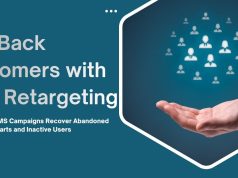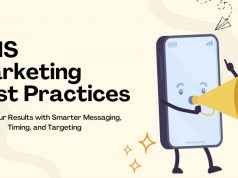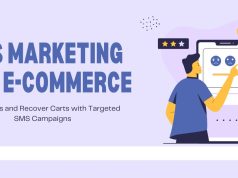Emailing and SMS messaging are some of the strongest direct channels of communication that a brand can use today. Although both these techniques deliver messages directly to your prospects, they have some distinct advantages that can alter the way you market if used in an effective way.
We’ll examine in depth what email and SMS marketing are, what they do and how they work, and why the combination of the two gives marketers a one-two marketing punch that delivers tangible results for verticals of all shapes and sizes.
Understanding Email Marketing
Email marketing is the practice of sending specific messages directly to inboxes of subscribers, often to market products, share news or build relationships. This online marketing channel has developed from being a basic newsletter to a complex medium for personalized custom-tailored communication.
The key to successful email marketing is building relationships with subscribers who have willingly given their email address. In the end, these subscribers are warm leads who are interested in your brand, after all, so they are more likely to engage with your content and become customers.
Core Components of Email Marketing
- Email Lists: Your list of e-newsletter subscribers is the core of your email marketing. And, lists can be broken down by demographics, action, who’s bought what, or how engaged someone is to serve up more personalized messages.
- Email Templates: Use professional templates to deliver the right look & feel for your emails. Now, most email providers have drag-and-drop editors that allow anyone to design beautiful email.
- Automation: With email automation you can send messages to contacts based on what they do. “Welcome” series, abandoned cart reminders and birthday perks can be automated to save time and keep that very personal touch.
- Analytics: Email solutions offer enhanced statistics around open rates, click through rates, and conversions, allowing you to optimize your efforts using performance driven insights.
What SMS Marketing Can Do for Your Business
With SMS marketing, you can send promotional messages, updates and alerts directly to customers’ mobile phones using text. Unlike email and social media, SMS is sent directly to someone’s phones and they check their phone dozens of times per day.
This opt-in marketing channel means you need your customers explicit permission before you send any kind of messages. This is a double-opt-in model which means you have a ready-built list of interested and engaged audience.
Key Elements of SMS Marketing
- Short Codes and Long Codes: Businesses use special phone numbers in order to send messages. Short codes are 5-6 digit numbers that are easily remembered and long codes are full 10 digit phone numbers.
- Keywords: These are the particular words that customers text to your number to join your messaging program. For instance, sending the text “DEALS” to 12345 might mean someone is signing up to receive your promotional missives.
- Character Constraints: SMS messages are 160 characters and every word matters. The limitation pushes advertisers to create shorter, attention grabbing ads free of extraneous fluff.
- Regulatory compliance: SMS marketing is one of the most regulated form of mobile marketing there is. Companies are required to adhere to the rules of the Telephone Consumers Protection Act (TCPA) and other rules so as not to suffer penalties.
Types of Email Marketing Campaigns
Promotional Emails
Such campaigns generate sales with offers, product alerts and limited time deals. Effective promotional emails add value and create urgency without feeling pushy.
Transactional Emails
These would include order confirmations, shipping notices, password resets, etc. Because customers invite in these emails (whom get) so, they do very well with opens.
Newsletter Campaigns
Frequent newsletters help to keep your brand in the forefront of prospects’ minds as you provide them with helpful content, industry perspectives and company news. They assist in establishing authority and keeping people entertained before the next promotion installment.
Automated Email Sequences
Automated welcome series, drip campaigns, and re-engagement sequences trigger when users take certain actions. These sequences look after your leads and walk them through your sequence.

Types of SMS Marketing Messages
Promotional Messages
These messages spur sales and advertise special offers. They may publicize flash sales, special discounts or new product debuts. The best promotional messages are those that make people feel urgency or that bring real value to people.
Transactional Messages
Transactional SMS helps customers stay updated with their Purchase or account activity. These include order confirmation and shipping notifications, as well as appointment reminders. These messages have higher open rates because customers anticipate and desire them.
Informational Messages
These messages deliver useful information that doesn’t overtly sell the product. These could be industry tips, how your company works, or educational content that demonstrates that your brand is the authority on the subject.
Benefits of Email Marketing
- Cost-Effective Reach
Email marketing provides a high return on investment. Studies show that email marketing brings in $42 for $1 spent, making it one of the most cost-effective marketing channels for businesses. - Detailed Analytics
Email service providers will give you full reports on subscriber actions such as opens, clicks, conversions and revenue. This information facilitates the self-adjusting mechanism of your campaigns. - Scalability
You can scale up email marketing easily as your company expands. Whether you’re sending to 100 or 100,000 subscribers, you pay the same low cost per email. - Personalization Capabilities
With recent email platforms, deep customization based on subscriber’s data, purchase history, and behavior is in fact possible. This level of personalization leads to higher relevance and response rates.
Benefits of SMS Marketing
- It Gets Instant Access and Open Rate
Text messages have an open rate of 98% and they are read within 3 minutes after being delivered. This instant reach also means SMS is an ideal medium for last-minute promotions or pressing messages. - Direct Communication Channel
SMS cuts through the clutter of crowded email inboxes and social media feeds. Your message is visible right on the customer’s phone, so it’s difficult to overlook. - Mobile-First Approach
At a time when mobile devices have taken over internet usage, SMS marketing is a perfect fit for how people consume content today. It had already met customers where they lived. - High Engagement Rates
SMS messages drive better click-through rates than emails, especially when it comes to time-sensitive offers or messages.
How Email and SMS Marketing Complement Each Other
- Complementary Strengths
Email is great at conveying detailed content, with media and rich content, and the visual cues. SMS is a perfect deployment of this protocol for an urgent message that is often time-sensitive and can prejudice the outcome if prompt action is taken. These two components, taken together, form an integrated communication program. - Cross-Channel Integration
Subscribers who interact with SMS AND e-mail have a higher lifetime value and higher purchase frequency. Send detailed product information through email and send messages to remind customers about limited-time offers. - Segmentation Opportunities
Segment subscribers with more advanced criteria through combined data across channels. Knowing that not all types of messages are consumed in the same way by the customer increases general campaign efficiency.
Best Practices for Email Marketing
- Subject Line Optimization
Write in trigger-happy subject lines that are value-driven and some form of curious. Stay away from spam-triggers and personalize where applicable. - Mobile Optimization
Make sure your emails are mobile friendly. Half of email is read on mobile — so it goes without saying: email design needs to be responsive. - List Hygiene
Clean your list periodically to purge inactive subscribers and invalid emails. It increases deliverability and engagement. - A/B Testing
Keep experimenting with various aspects of your emails, such as subject lines, sending times, and content, to ensure you are improving performance each time.
Best Practices for SMS Marketing
- Timing Your Messages
Send on the time when your readers are mostly undistracted and are paying attention to your messages. Do not send messages at time other than a reasonable one to send messages. - Frequency Management
Find a middle ground between being top-of-mind and message fatigue. But I find that 2-4 messages per month works best with most businesses (though it varies by industry and audience). - Clear Call-to-Actions
Each message should clearly articulate what its purpose is and what the next action or step should be. Whether you want visiting your store, buy a product, or visiting your page, make the action you want OBVIOUS. - Compliance and Legal Considerations
Never message first without getting consent. Provide explicit instructions on how to opt-out of every message, and keep detailed records of subscribers’ consent.
Industries That Benefit Most
- Retail and E-commerce
Retailers communicate sales, exclusive offers and abandoned cart reminders through both channels. Email supplies description of the product that is detailed whereas SMS make urgency to time sensitive deals. - Healthcare
Email represents educational materials and length appointments, SMS is in charge of reminders and urgencies. - Restaurants
For restaurants, highs and lows, such promotional offers and new menu announcements take place through both channels. Email is great for detailed menus and stories about your history, while SMS is ideal for last-minute promotions. - Financial Services
Banks have email for statements and education; they can use SMS for alerts and fraud because of its immediate nature and security.
Measuring Success Across Both Channels

Email Marketing Metrics
- Open Rate
The ratio of those who open your emails to the people who receive them. - Click-Through Rate
The number, as a percentage, of people who click the links in your emails. - Conversion Rate
The proportion of readers that take a desired action after they have clicked on your email. - Unsubscribe Rate
The percent of subscribers that unsubscribe from your emails.
SMS Marketing Metrics
- Delivery Rate
This the percentage of message that are successfully delivered to the intended recipient. - Open Rate
Delivered messages opened and interpreted as a percentage of total delivered messages. - Click Rate
Measurement of how many people click links within your messages. - Opt-Out Rate
The number of your followers opting out of receiving your messages.
Common Mistakes to Avoid
Email Marketing Pitfalls
Too frequent posting without something valuable to say creates high unsubscribe rates. Neglecting to make the website mobile friendly will lower engagement by far. Failing to clean your list will give you a poor delivery rate.
SMS Marketing Mistakes
Sending an excess of messages annoys subscribers and results in massive opt-out rates. For non compliance, you face fines up to large amounts and potential jail time. Generic & irrelevant messages diminish effectiveness and undermine brand perception.
Combined Email and SMS in Practice
Choosing the Right Platforms
Choose a platform that includes the functionalities you are looking for (automation, segmentation, analytics, etc.) Most of the new platforms themselves add both email and SMS feature, which simplifies the process of management of cross-channel campaigns.
Building Your Lists
Begin to collect the email addresses and phone numbers of potential customers. Website opt-in forms, in-store sign-up, social media campaigns and competitions can all be used to achieve this.
Creating Your First Campaigns
Start with basic welcome series for all new subscribers on the channels. This helps manage your audience’s expectations and kicks off the relationship.
Maximizing Your Marketing Potential
Email and SMS advertising are two of the most direct and effective means of contacting your customers. The power of email is in delivering rich, detailed content that educates and nourishes relationships. SMS also offers that instant and urgent communication which encourages swift responses.
What I’ve noticed, is the most effective companies use both channels consistently, utilizing each for its strengths, all while creating integrated campaigns that move the customer through their buying journey. Begin with one channel to establish your foundation, and then slowly spread to both for the biggest hit.
Your buyers operate in a multi-channel universe. Getting to them where they are, with the right message at the right time, over the right channel, is essential these days for marketing success.
Learning what email and SMS marketing are provides a solid foundation, while diving into e-commerce email marketing offers actionable strategies to drive customer engagement and sales.









